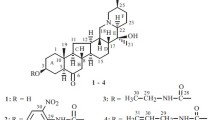Abstract
The hydrolysis of ICRF-187 and two model compounds, 4-methylpiperazine-2,6-dione (4-MP) and 3-methylglutarimide (3-MG), was investigated over the neutral to alkaline pH range at 25°C and an ionic strength of 0.5 (sodium chloride). The purpose of the study was to correlate the influence of molecular changes to the reactivity of these imides. Additionally, an improved chromatographic resolution of all the components of the degradation and NMR confirmation of the identity of the degradation products are presented. Based on the study of 4-MP, which is essentially half of an ICRF-187 molecule, and 3-MG, which has a carbon in place of the piperazine nitrogen, several conclusions can be drawn with regard to the stability of ICRF-187. The tertiary piperazine nitrogen/s of 4-MP and ICRF-187 contributed to the base-catalyzed hydrolysis of these compounds above pH 7 and caused a significant decrease in the pK a values of the imide moiety of ICRF-187 and 4-MP compared with 3-MG. One 2,6-piperazinedione ring of ICRF-187 was shown to affect only minimally the rate of hydrolysis of the second ring. ICRF-187 hydrolyzes by parallel consecutive pathways forming two monoacids with one ring opened and, subsequently, the diacid with both rings hy-drolyzed._________________________________
Similar content being viewed by others
REFERENCES
A. J. Repta, M. J. Baltezor, and P. C. Bansal. Utilization of an enantiomer as a solution to a pharmaceutical problem: Application to solubilization of 1,2-di-(4-piperazine-2,6-dione)propane. J. Pharm. Sci. 65:238–242 (1976).
K. Hellman and E. O. Field. Effect of ICRF 159 on the mammalian cell cycle. Significance for its use in cancer chemotherapy. J. Natl. Cancer Inst. 44:539–543 (1970).
R. J. Belt. Prevention of adriamycin-induced cardiotoxicity by ICRF-187 (NSC-169780). Proc. Am. Soc. Clin. Oncol. 3:Abstr. C-105 (1984).
E. H. Herman. Influence of vitamin E and ICRF-187 on chronic cardiotoxicity in miniature swine. Lab. Invest. 49:69–77 (1983).
J. L. Speyer, M. D. Green, E. Kramer, M. Rey, J. Sanger, C. Waerd, N. Dubin, V. Ferrans, P. Stecy, A. Zeleniuch-Jacquotte, J. Wernz, F. Feir, W. Slater, R. Blum, and F. Muggia. Protective effect of the bispiperazinedione ICRF-187 against doxorubicin-induced cardiac toxicity in women with advanced breast cancer. N. Engl. J. Med. E. 319:745–752 (1988).
B. B. Hasinoff. The hydrolysis of the doxorubicin cardioprotective agent ICRF-187 ((+)-Bis(3,5-dioxopiperazinyl-l-yl) propone). Drug Metab. Disp. 18:344–349 (1990).
M. J. Baltezor. Preparation and Evaluation of Bis-(3-carboxy-4-hydroxy-1-naphthyl) Alkanones as Novel Complexing Agents. Complexation with some Quaternary Polycyclic Aromatic Compounds, Ph.D. dissertation, University of Kansas, Lawrence, 1976.
A. Simonelli. A Report to the National Cancer Institute (Contract PH-43-68-1284), University of Michigan, Nov. 1971.
M. N. Kahn and A. A. Khan. Kinetics and mechanism of hydrolysis of succinimide under highly alkaline medium. J. Org. Chem. 40:1793–1794 (1975).
J. T. Edward and K. A. Terry. The hydrolysis of amides and related compounds. IV. Diacetylamine and succinimide in aqueous alkali. J. Chem. Soc. 3527–3530 (1957).
P. Nuhn and P. Woitkowitz. Alkalikatalysierte hydrolyse einiger succinimide. Pharmazie 33:202–205 (1978).
G. J. Yakatan and T. Fan. Kinetics of hydrolysis of succinimides. Drug Dev. Ind. Pharm. 3:315–338 (1977).
J. Tirouflet and E. Le Trouit. Cinetique de 1'Hydrolyse des Phtalimides en Milieu Tampon (Dosage Polarographique). C.R. Acad. Sci. 241:1053–1055 (1955).
J. W. Wesolowski, S. M. Blaug, T. F. Chin, and J. L. Lach. Kinetics of degradation of glutethimide. J. Pharm. Sci. 57:811–815 (1968).
T. Yamana and Y. Mizukami. Studies on the stability of drugs. IV. On the decomposition of glutethimide in alkaline solution. Yakagaku Zasshi 81:1383–1386 (1961).
B. H. Chase and A. M. Downes. The synthesis of 14C-labelled l-diethylcarbamyl-4-methylpiperazine (“Hetrazan”). J. Chem. Soc. 3874–3877 (1953).
K. Yamaoka, Y. Tanigawara, T. Nakagawa, and T. Uno. A pharmacokinetic analysis program (MULTI) for microcomputers. J. Pharm. Dyn. 4:879–885 (1981).
A. Albert and E. P. Serjeant. Determination of Ionization Constants, 3rd ed., Chapman and Hall, New York, 1984, pp. 70–101, 14–39, 130–134.
E. C. Kornfeld, R. G. Jones, and T. V. Park. The structure and chemistry of actidone, an antibiotic from Streptomyces griseus. J. Am. Chem. Soc. 71:150–159 (1949).
D. D. Perrin, B. Dempsey, and E. P. Serjeant. pKa Prediction for Organic Acids and Bases, Chapman and Hall, New York, 1981, pp. 13–15, 16.
H. F. Walton and A. A. Schilt. The ionization constant and rate of hydrolysis of succinimide. J. Am. Chem. Soc. 74:4995–4996 (1952).
H. V. Euler and A. Olander. Uber die Hydrolytische Spaltung des Succinimids. Z. Phys. Chem. 137:393–398 (1931).
M. Bergon and J. P. Calmon. Kinetics and mechanism of hydantoic ring opening. The alkaline hydrolysis of 3-arylimidazolidine-2,4-diones to 5-arylhydantoic acids. J. Chem. Soc. Perkin II 493–497 (1978).
K. M. Dawson. Studies on the stability and cellular distribution of dioxopiperazines in cultured BHK-21S cells. Biochem. Pharmacol. 24:2249–2253 (1975).
T. G. Burke, T. D. Lee, J. van Balgooy, and J. H. Doroshaw. Characterization of the aqueous decomposition products of (+)l,2-bis(3,5-dioxopiperazinyl-1-yl)-propane (ICRF-187) by liquid chromatographic and mass spectral analysis. J. Pharm. Sci. 80:338–340 (1991).
C. Dorlet. Etude de l'Hydrolyse Alcaline de l'α-ethyl-α-phenyl Glutarimide. J. Pharm. Belg. 24:509–520 (1969).
B. R. Vishnuvajjala and J. C. Cradock. Tricyclo[4.2.2.02,5]dec-9-ene-3,4,7,8-tetracarboxylic acid dimide: Formulation and stability studies. J. Pharm. Sci. 75:301–303 (1986).
W. Sadee, J. Staroscik, C. Finn, and J. Cohen. Determination of (±)-1,2-bis(3,5-dioxopiperazinyl)propane plasma levels in rats, rabbits, and humans by GLC and mass fragmentography. J. Pharm. Sci. 64:998–1001 (1975).
Author information
Authors and Affiliations
Rights and permissions
About this article
Cite this article
Sisco, J.M., Stella, V.J. Is ICRF-187 [(+)-1,2-Bis(3,5-dioxopiperazinyl-1-yl)propane] Unusually Reactive for an Imide?. Pharm Res 9, 1076–1082 (1992). https://doi.org/10.1023/A:1015818931062
Issue Date:
DOI: https://doi.org/10.1023/A:1015818931062



